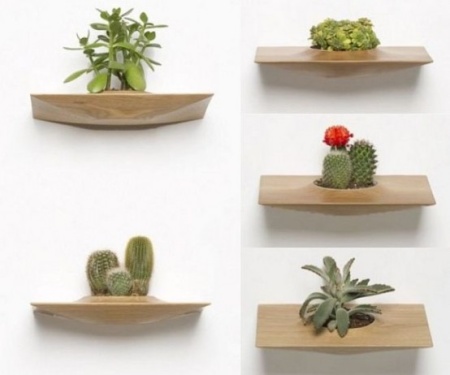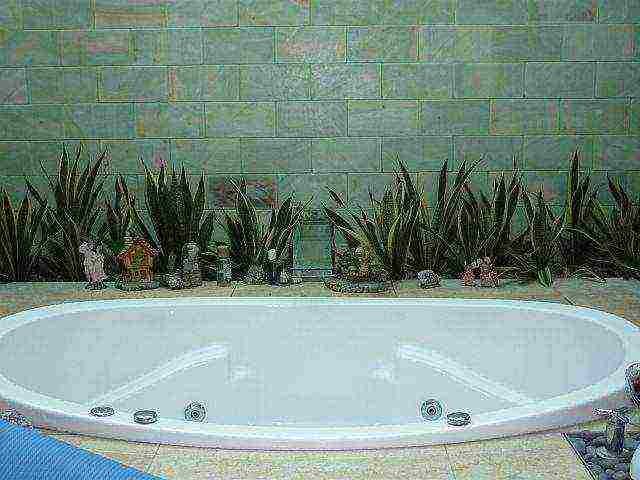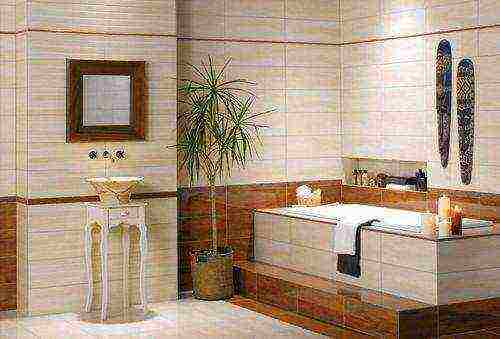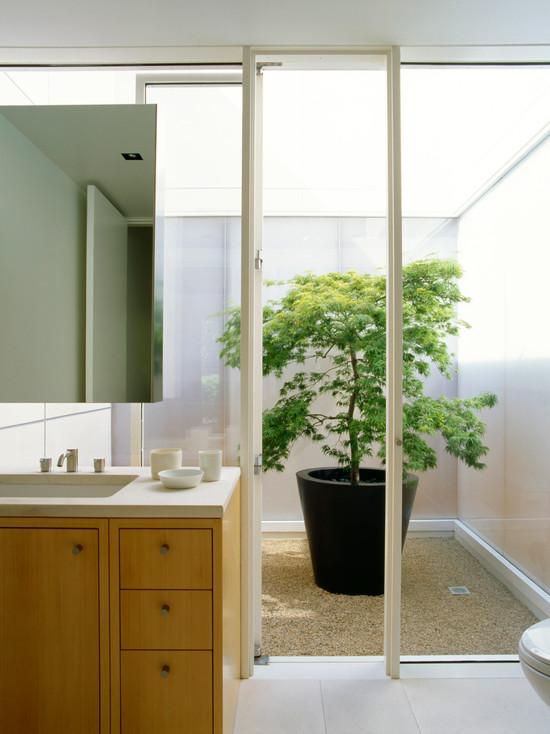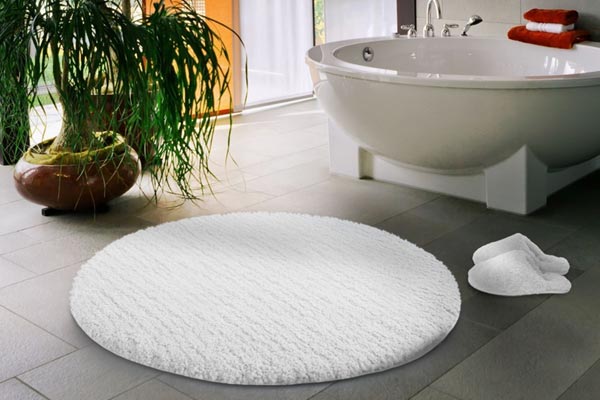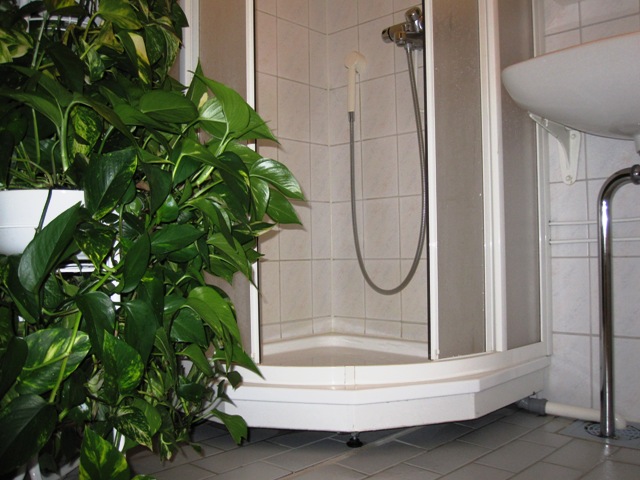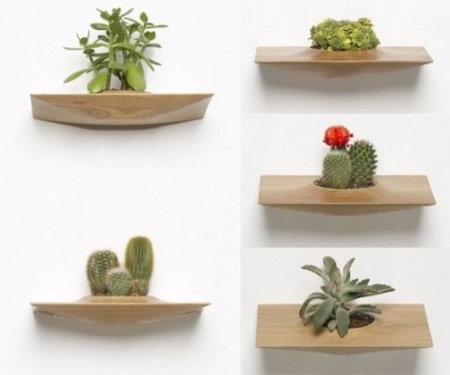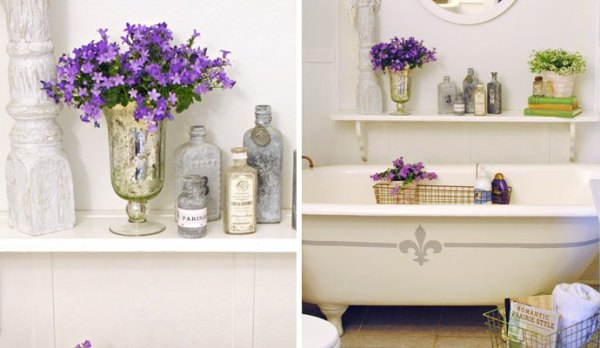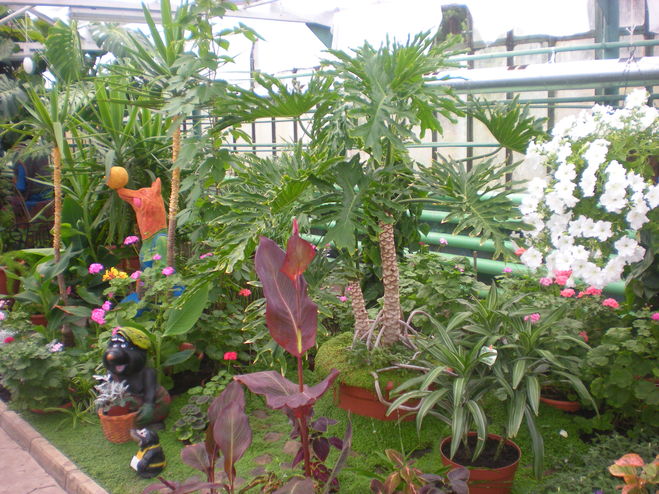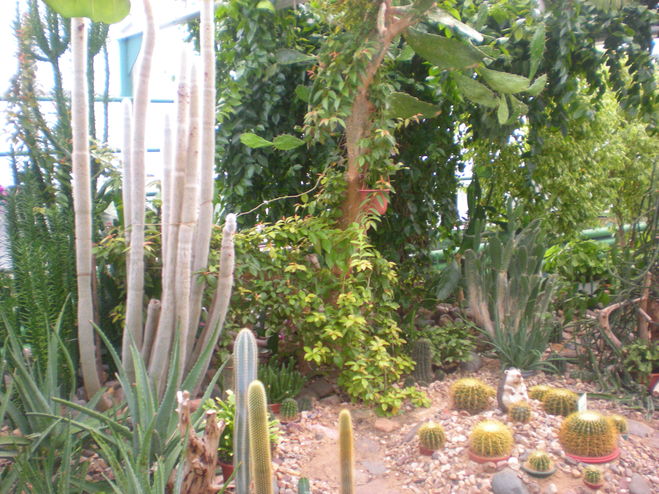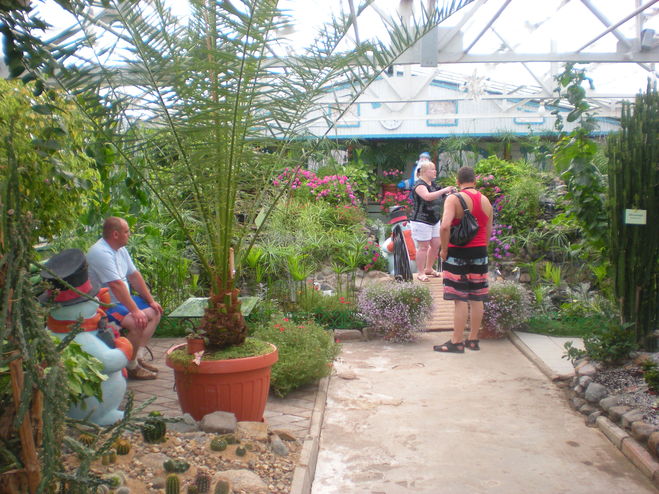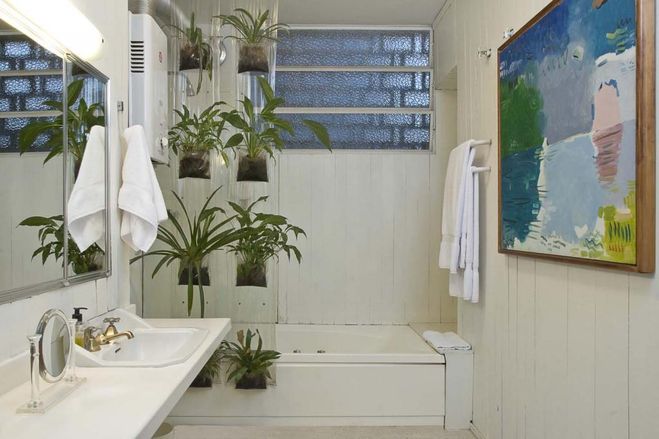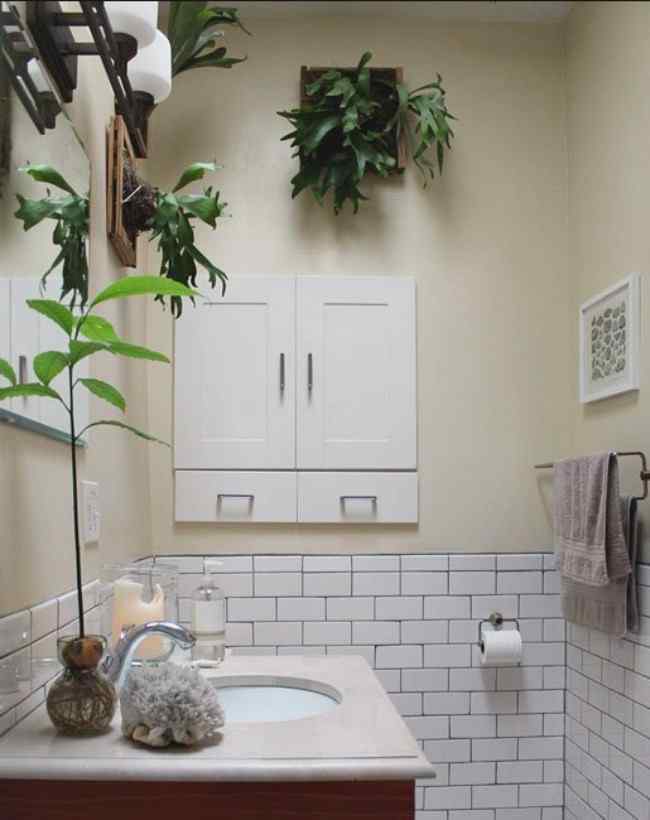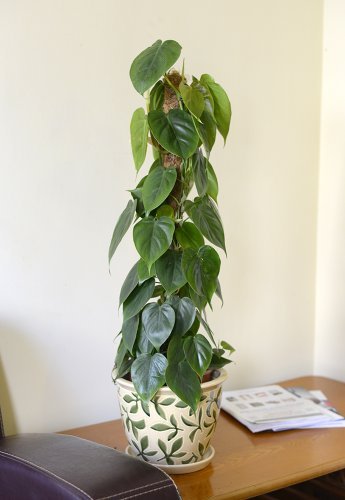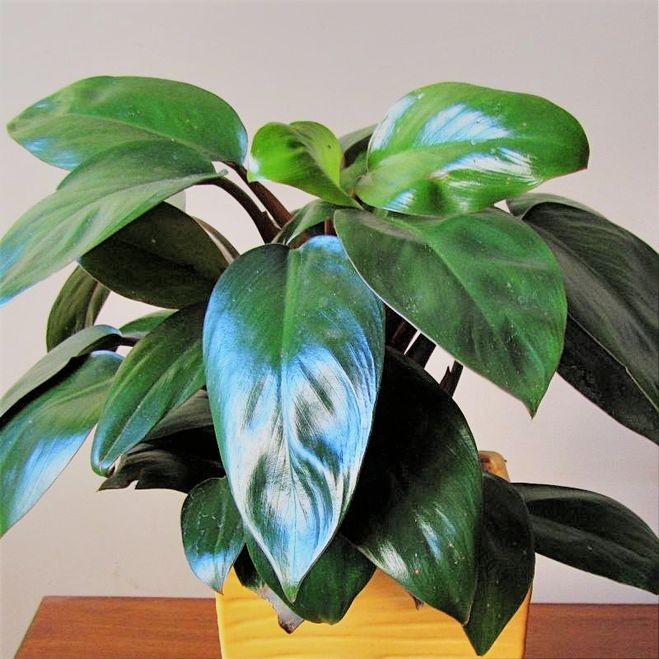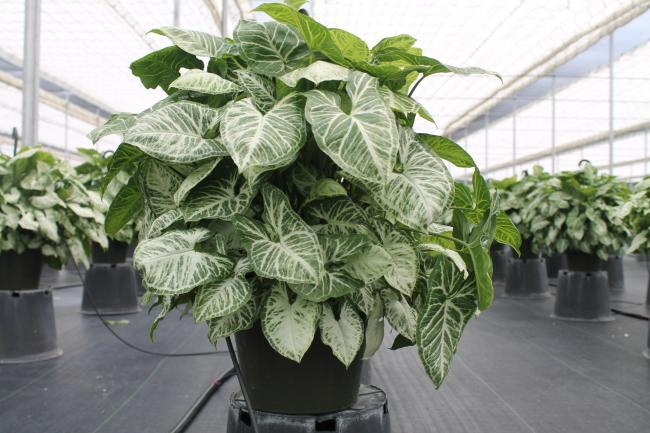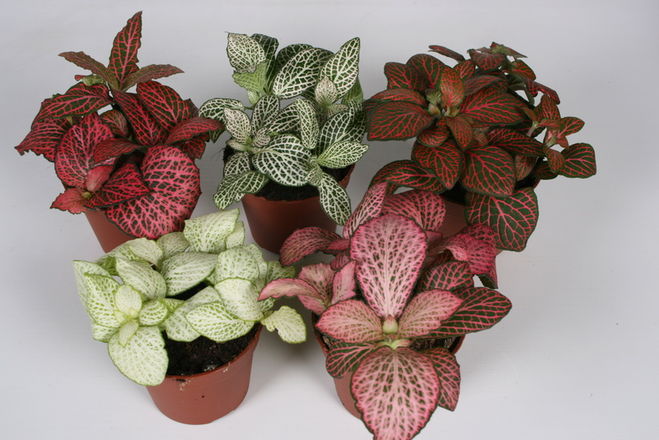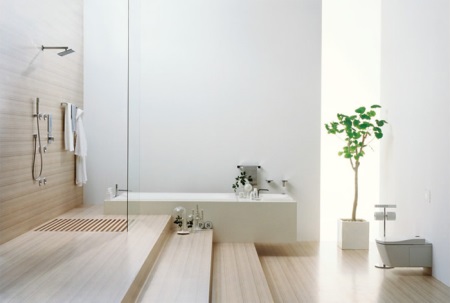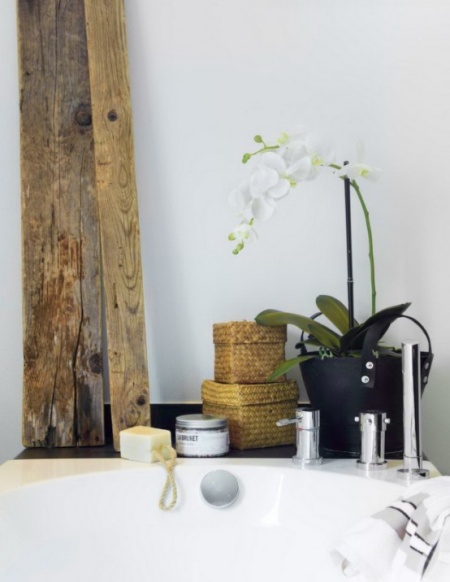We arrange flowerpots wisely
We figured out what flowers are placed in the bathrooms, now let's find out how to arrange flowerpots with flowers so that they decorate, and do not take up space.
If the bathroom has a window, then light-loving plants can be placed on the windowsill. Vases with flowers that do not tolerate direct sunlight should be placed on the floor or pedestals opposite the mirror.
If the window frame does not allow placing flowers directly close to the glass, you can place the pots on stands closer to the windowsill; this option is not available in windowless bathrooms. Therefore, flowers in the bathroom, where there is no window, offer much more options for design solutions.
Shelves
A real find will be a variety of hanging shelves. Arrange as you like, because in a windowless bathroom, no matter what places you choose, they will be independent of the light source.
Ampelous flowers are best placed on higher shelves. Whereas compact and undersized species are set to a height of no more than 1.5 m.
By the way, hanging shelves and hooks are the most acceptable version for a small room without windows. Shelves do not take up extra space. You can place them above the bath, where the plants will not interfere and take up space.
Cabinets and Cabinets
If the dimensions of the bathroom allow, then you can use cabinets or cabinets to arrange flowers. Thinking through the interior of the bathroom, flowers can be made the basis or addition.
In the first case, a separate cabinet is installed for the flower garden, in the second, the cabinet with bath accessories is simply decorated with small flowerpots.
Floor
Bathroom plants can also be installed directly on the floor. In particular, we are talking about high, palm species. But, remember that not all plants tolerate contact with a cold floor.
For example, flowers of the ficus family, when the root system freezes, will very quickly shed foliage. Therefore, when placing flower vases on the floor, take care of a slight elevation.
Where is it undesirable to put plants?
Otherwise, the placement of flowers in the bathroom depends entirely on the size of the bathroom and your imagination.
True, there are some forbidden places where it is not recommended to put flowers:
- do not place flowerpots close to the sink, bath or shower;
- placing flowers next to radiators and heaters is a bad decision;
- do not use the washing machine as a plant cabinet.
There are still some chores with growing plants in the bathroom. But, firstly, they are minimal. And secondly, the pleasure and benefits of the effect obtained are worth it to grow flowers even in the bathroom.
Forced deterioration of conditions for phalaenopsis
Our apartment is under renovation. Plastic windows were installed, and wooden slopes were made by other workers, without insulation. I removed the slopes at the end of November, now the second week has already begun, and the weather is appropriate for winter. Imagine that the slopes (exposed concrete) are icy, from under the lumps of mounting foam between the slopes and the window there is a blow.
There are no other content options, except for the window, for my phalaenopsis. If you put them deep into the room - there is zero light. So for now I left my orchids on the window. I don't know what the temperature is there; pots are cold. But ... At the same time, the young leaf of the revived phalaenopsis has already doubled in size and risen up - which means that not everything is so bad. However, as my intuition tells me, it is impossible to keep orchids in such conditions for a long time. And after watering them, again I understand intuitively - before putting the pots on the windowsill with such a temperature, it will be necessary to hold the phalaenopsis in the back of the room. True, I have not watered them during this time, only going to this weekend.
I water the phalaenopsis like this. In the bathroom, I dip the orchid pot into a bucket of water for 30-40 minutes (or maybe for an hour, as it turns out - I don’t keep track, I’m doing other things).I first put the pot on the bark on both sides so that it does not float up, the shampoo bottles - the bath ... I leave all the watered phalaenopsis in the bathroom until the next morning, and in the morning I take it out and put it in place. It turns out that when I water, I keep orchids in the bathroom for a day.
Here are such revealing stories for those who cry about their "dying" orchids and consider phalaenopsis a delicate plant. My examples show that phalaenopsis can withstand even the Spartan conditions described above! It's just that under very, very unfavorable conditions of detention, phalaenopsis, as it were, falls asleep and suspends its development until better times. I repeat once again: as long as the plant has at least one living root, phalaenopsis is alive. Only the aerial part dries up or dies, and even if it completely disappears, do not throw away the orchid. There is at least one living root, fine - leave the phalaenopsis alone, and do not pour all your love on it. And one more thing: the dried bark in a pot with an orchid (as it sometimes seems to a flower grower, because there are no smudges of water between the pot and the bark) is not an indicator that the plant lacks moisture, and the phalaenopsis needs to be watered urgently. Remember that in the tropics, orchids survive the dry season very well.
Ludmila BogGardenia.ru "Floriculture: Pleasure and Benefits"
All about orchids on the site gardenia.ru
Weekly Free Digest of Gardenia.ru Site
Every week, for 10 years, for our 100,000 subscribers, an excellent selection of relevant materials about flowers and gardens, as well as other useful information.
Subscribe and receive!
(unsubscribe with one click)
Choice of colors
The following plants should be considered as an addition to the interior of the bathroom:
- Large (Fatsia, monstera attractive);
- curly (philodendron, epipremnum);
- Bush (hamedorea, aglaonema);
- Blooming (violets, Decembrists, chrysanthemums).
If the size of the room allows, then you may like a fern, ficus or howea. These flowers are quite large but look great. Plus, they easily get along under the conditions of keeping in the bathroom.
https://youtube.com/watch?v=ULt07wEo59o
Without windows and phytolamps
The probability of meeting a window in the bathroom, as we have said, is quite small. Plus, not everyone wants or can install phytolamps. And I want to see flowers inside this room. How to be in that case?
In fact, we can offer three options.
- Use fresh, cut flowers. Place small bouquets in vases near the mirror, on shelves, racks, washing machine. If you have your own garden, or there are no problems with access to flowers, you can change the decor once a week. The presence of beautiful colors makes a serious difference in the perception of the interior.
- Consider using artificial flowers. Not everyone perceives them properly, associating them with certain events. Nevertheless, with the help of artificial plants, you can create magnificent decorations, hide unsightly communications, and mask cracks that have appeared on the walls. Most importantly, they do not need to be looked after. High-quality artificial flowers look great, are a copy of living plants.
- Dried flowers should not be discounted. With their help, you can also perfectly decorate the interior. But keep in mind that it is better to immediately treat such plants with moisture-protective compounds, otherwise they may begin to decay over time.
https://youtube.com/watch?v=N5p_5vFP920
Location options
So, you decided to put flowers in your place, decorating the bathroom with them. But here a completely natural question arises - where to put them. Indeed, the bathroom is not a window sill that can be completely covered with flowerpots. Plus, not in every zone, flowers will be appropriate. They can simply get in the way under the arms and legs. Therefore, it is necessary to choose the best places where the flowers will decorate the room and not cause discomfort.
Floor.On the floor, you can install large, tree-like plants, tall dried flowers or large bouquets of fresh flowers. It is best to choose empty corners for this, where you perform a minimum of actions. For example, for many, one of the corners of the bathroom is allocated for the placement of basins or pans;
Windowsill. Rare, but still an option. In addition, it is quite possible to create an imitation of a window. Many install decorative frames with a window sill, creating the effect of a real window. So why not bring it even closer to the present by installing a few plants;
Shelves. If you opted for small, climbing plants, then the shelves will be the best place to place them. Choose a height of their location so as not to cause discomfort to you. Experimenting with their arrangement is a pleasure for those who like to decorate a room. Ladder, chess principle, steps and so on;
Racks and bedside tables. Someone buys spacious furniture, and half of the space is empty. So it is quite possible to take flowers. Some specifically buy separate racks allocated specifically for landscaping the premises.
Here, as you understand, it is important to have an impressive bathroom area;
Cabinets. If you are unable to allocate shelves for flowers, then you can use the space on the wall cabinets
At the same time, it is advisable not to put them under the very ceiling, otherwise care will give you a lot of trouble.
Well, the plants in the bathroom have every right to be placed. However, in order to achieve the desired result, certain conditions must be met.
First of all, you should pick those flowers that will not wither after a couple of weeks. You also need to create conditions for the maintenance of life and the development of flowers. Keep in mind that even the most stable plantings have a limit. And, of course, without proper care, the flower will disappear.
So act wisely, prudently. Plants should please and bring pleasure. Otherwise, it makes no sense to green the bathroom.
What to look for when choosing a flower finish
First you need to decide what exactly the image of flowers should be: in the form of a whole picture or in the form of an ornament on the tiles. The first option is a kind of photo wallpaper, only for a “wet” room. This decoration is a ceramic panel depicting photographs or paintings with flowers. It is placed above the bathroom, and the size is selected depending on the total area of the room. There are several types of panels:
- in the form of a solid tile;
- assembled from several tiles of the same shape;
- freesize panel, which does not have a clear geometry and consists of several parts of arbitrary shape;
- mosaic.
A solid tile is a ceramic "picture" of a small size. It is suitable for small bathrooms in combination with the main finishes in neutral tones.
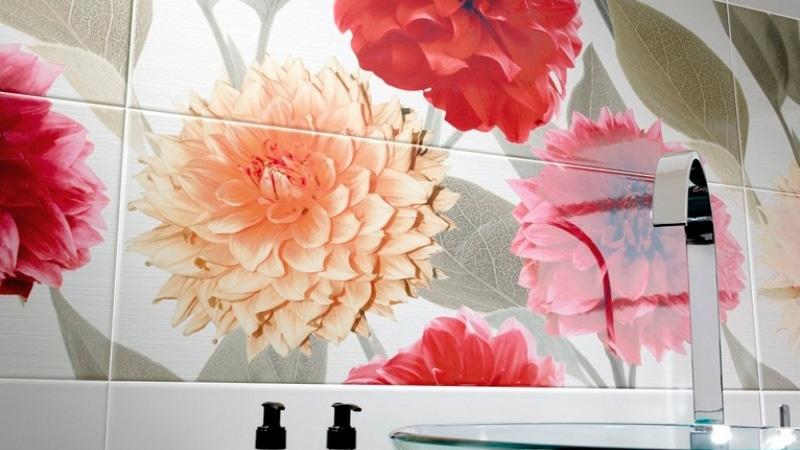
It looks interesting panel-frisize. This option provides for the formation of an overall picture of tiles of different shapes and sizes, with a pattern partially or completely applied to them. This solution is ideal for decoration in modern high-tech or minimalist styles.
Mosaic is the most beautiful and at the same time expensive type of panel, requiring a large area. Mosaic looks great from the outside, visually expands the walls, creating the illusion of open space, but to appreciate it, you need to look at it from afar.
The use of panels not only decorates the room, but also visually corrects its size: a vertical “picture” raises the ceilings, a horizontal one expands the walls. In addition, the three-dimensional drawing creates the illusion of a window or open space, "enlarging" even the most modest room.
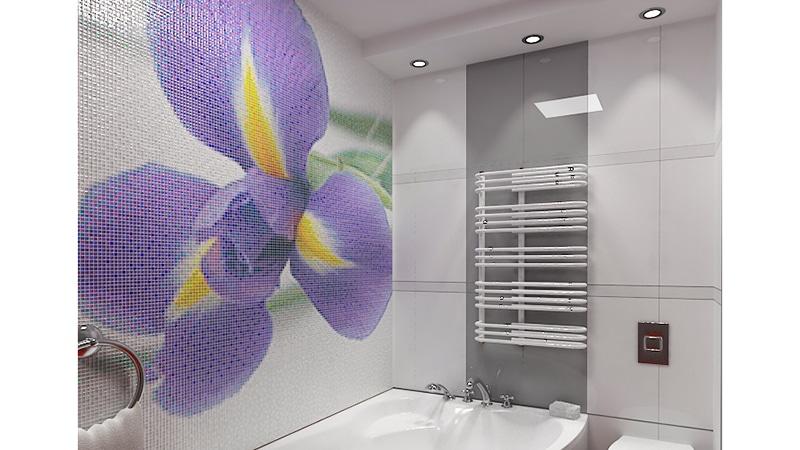
A few tips for tiling with flowers:
- in the case of using a panel, it should be the main focus in the room.The background finish is selected in pastel colors or white is used;
- the panel can be framed with a decorative border with an unobtrusive and as simple as possible ornament (it can be floral), but it is better to do without it;
- when using separate tiles with the image of flowers, they are placed mixed with plain tiles so that the walls do not look clumsy.
What plants are suitable for the bathroom
|
Aloe vera.
Yes, yes ... A plant that is quite familiar to all of us feels great in the bathroom, even with low lighting. Among other things, it can always be used to treat scratches, insect bites, burns, as well as to treat colds. Aloe vera is a great choice, even for beginner gardeners, as it is very hardy and hard to kill. |
|
| Sansevieria. Sansevieria, like aloe, is one of the more hardy plants, making it an ideal choice for the bathroom. The plant does well in low light conditions. Moreover, sansevieria filters out formaldehyde, which is part of cleaning products, toilet paper, tissues and even some cosmetics. | |
| Bamboo This plant can grow in almost any light - even without soil! Simply place the bamboo root in a container filled with a few centimeters of pebbles. Then fill the container halfway with water and keep an eye on the water level, periodically topping up. Bamboo with curly stems looks great! | |
| Dracaena There are several varieties of Dracaena, but all of them suffer from a lack of moisture, which is manifested in the brown dry tips of the leaves. A familiar picture? The natural humidity of the bathroom can be a great incentive to grow dracaena in the bathroom. | |
|
Orchid
Flower growers know how fastidious these beauties are. But they feel great on the bathroom windowsill. Yes, right on the windowsill. In a bathroom without windows, an orchid will not survive, as it needs, albeit indirect, but sunny color. If the bathroom windows face the sunny side, then it is recommended to place the orchids not on the windowsill, but near the mirror, so that the sunlight is first refracted, and only then falls on the plant. Learn how to identify the type of orchid. |
|
|
Fern.
The natural environment for ferns to grow is similar to what you might offer them in a bathroom—filtered, low light and high humidity. Place a hardy fern in the corner of your bathroom and enjoy! |
|
| Spathiphyllum Spathiphyllum is a surprisingly unpretentious plant that perfectly cleans the air from household impurities. The most acceptable growing conditions are minimal sunlight and high humidity. That is why the spathiphyllum will feel great in the bathroom. | |
| Aspidistra These leafy green plants can adapt to varying light conditions, but it's best to place the aspidistra away from a window if your bathroom has one. | |
| Chlorophytum Say, this is the plant of our grandmothers, it is already unpopular! Nothing like this! Chlorophytum is gaining popularity again due to the beauty of its leaves and ease of care. To keep chlorophytum in order, you can cut off new shoots so that the plant does not lose shape. Chlorophytum is one of the best plants for purifying the air from the remnants of household chemicals. And this is another reason for placing it in the bathroom. | |
| Livistona Livistona is a palm plant from the tropical and subtropical rainforests of Southeast Asia and Northern Australia. It takes its name from the surname of Baron Liviston, who founded the Botanic Gardens in Edinburgh in 1670. Livistona has fan-shaped leaves. The interestingly shaped leaves make the plant the most elegant among miniature palms. |
In addition to the above plants, I would like to highlight 6 more that feel great in the dark, and therefore are suitable for use in the bathroom.
Benefit
It is important to remember that the plants in the bathroom, where there is no window, not only carry an aesthetic message, but also bring undeniable benefits:
- in addition to the ability to release oxygen, thereby purifying the air, the flora in the bathroom prevents the formation of fungal formations, normalizes the microclimate, improves water and gas exchange, absorbs microparticles of heavy metals;
- flowers with a natural aroma inherent in them deodorize the air of a room with or without a window;
- living indoor greenery is a pleasant reminder of summer, improves mood;
- Flora plays an important role in the interior, making it colorful and complete.
From all of the above, the question arises: "can living vegetation grow normally and exist in a bathroom that does not have windows - they can." There are varieties for which such conditions are the most acceptable and the absence of a window will not become an obstacle for them to delight with their magnificent views every day.
Phalaenopsis is the most unpretentious orchid
by Bog L., photo by the author
It is no coincidence that Phalaenopsis is considered the most popular and unpretentious orchid that successfully grows and blooms in the house.
In the title photo: blooming white phalaenopsis, which lives at my work in a regular office.
Phalaenopsis are characterized by long peduncles, on which beautiful flowers of various colors bloom, with various combinations of patterns and patterns. This orchid got its Latin name (Phalaenopsis - "butterfly orchid") for the specific shape of the flowers: an unknown discoverer mistook them for a flock of bright butterflies ...
In stores, blooming phalaenopsis are sold out quickly, they are cheaper compared to other types of orchids. The experience of many other growers and my own examples confirm that phalaenopsis is indeed the most unpretentious orchid.
Growing conditions
- Temperature. The bathroom is always high humidity. If at the same time to is too low, mold and various fungi may appear. The optimal level is 16-22 ° C. Otherwise, you should take extra care of additional heating. But still from time to time the room must be ventilated. If ventilation is poor, leave the door open at night.
- Lighting. Just because windowless bathroom plants can get by with minimal light doesn't mean they can survive in total darkness. They need extra lighting. To do this, you need to install either fluorescent lamps or phytolamps. You should choose energy-saving ones, since they will have to be turned on for 10-14 hours. In this case, the illumination of the room should be at least a thousand units. For measurements, you can use a special device - a luxmeter. If you install reflectors on the walls or ceiling, then the illumination will be higher due to the reflected light.
However, it happens that even with additional light sources, plants lack it. The lack of lighting is manifested in the following:
- the plant is stretched;
- grows poorly;
- foliage becomes dull and small;
- flowers or buds fall off, and if they open, they are small and pale;
- lower leaves fall off;
- apical buds stop developing.
These signs appear within one and a half to two months. To save the plant, it must be moved to a more lit room.
Placement of flowerpots
In addition to beauty, plants can create certain inconveniences. To prevent this from happening, they need to be skillfully placed.
General recommendations:
- place flowerpots on flat surfaces;
- ampel varieties can be placed on the walls, so they will not interfere with the use of the bathroom or furniture;
- it is not recommended to place flowerpots near a washstand, shower cabins for two main reasons: the first - they can be touched by accident, dumped on the floor, the second - not all varieties like direct splashes on the leaves, base or stem;
- you should also not place flowerpots near heating radiators above the window;
- feed with granular fertilizers.
A few tips on how to place flowerpots, which ones to put where, so that they do not create inconvenience when using.
Floor
You can put tree-like varieties with lush crowns. They look very good in the corners, where different actions are performed minimally or very rarely. Various palm trees, tall, not very lush plants are suitable for placement on the floor. So that plants do not clutter up space and passages, they need to be placed in places that are practically not used for various kinds of actions. A place under the sink is perfect, but it is not recommended to place plants near the bathtub and shower stall, as they can be accidentally hooked and damaged. With this placement, a soap solution can get on the leaves of plants, which will lead to their death.
Shelves
This piece of furniture is a great alternative to a window sill, especially in windowless bathrooms, and you can hang them as you like: in steps or in a checkerboard pattern. Shelves are installed on free sections of the wall. Hanging flowers look wonderful on them, especially if they are also flowering plants.
To diversify the interior of the bathroom, you can arrange the shelves in a chaotic manner and paint them in different colors. Try this method and the bathroom will play in a completely new way. This is a great way to fill in empty corners in a room. Ivy and Philodendron climbing are suitable for installation on shelves, and if the shelf is installed above the mirror, then these plants will look great hanging from it and framing the mirror.

Sources
- http://VannayaSovety.ru/aksessuary/rasteniya-dlya-vannoy-komnaty.html
- https://podokonnik.temadnya.com/1445930917623236983/rasteniya-dlya-vannoj-komnaty-bez-okon/
- http://www.o-vannoy.ru/dizajn/cvety-dlya-vannoj-komnaty/
- https://www.syl.ru/post/home-and-family/12848
- http://dacha-posadka.ru/virashivanie/kakie-rasteniya-mozhno-vyraschivat-v-vannoy-komnate-bez-okna.html
- http://www.o-vannoy.ru/dizajn/rasteniya-cvety/
Bathroom plants without windows
This situation is not so favorable for lovers of indoor plants, but it is not hopeless either. You can install backlights. These lamps are not cheap and will require some space in the bathroom.
An easier option is to move the plants into the bathroom for a while. Freshly blooming plants in the bathroom are provided with an extended flowering period due to low lighting. Installed in suitable pots, such plants will perfectly decorate the bathroom for a month or two, after which they can be sent “to a sanatorium” (provide them with enhanced nutrition and lighting elsewhere, for example, in the garden or on the balcony), replacing them with others. It should be remembered that variegated plants (those with multi-colored or variegated leaves) need more light in order for the pattern on the leaves to develop. In shaded areas, preference should be given to shade-tolerant plants with monochrome foliage.
What flowers can be grown in a bathroom without a window Name and photo
There is a bathroom without a window. Light during the day there is on for 1-2 hours in total. Is it possible to keep any houseplant there?
What are these plants? Title, photo?
In our ordinary bathrooms, which do not have windows and, as a result of the influx of daylight, not a single indoor flower will survive. I tried, at one time I put a pot of Sansevieria high and low. I turned on the light for them, although now, given the cost of electricity, such a backlight will cost a pretty penny. It's not about that. After about two weeks, my flowers began to curl up, although they are considered one of the most unpretentious! I also put homemade violets, the scenario was the same as with Sansevieria. I also had another experiment, I hung crested Chlorophytum in the dressing room on the stairs. This is the space that is formed when a second door is placed in the entrance to two apartments, such an additional corridor. Chlorophytum also began to hurt there. I no longer experiment, the flowers stand on the window or near it on stands. Of course, you can put flowers in the bath if there is a window there or put them for a short time, purely for beauty, but why torture the flowers with rearrangements, they don’t like that.
Everyone’s bathrooms are different, the conditions are different, so it’s impossible to say unequivocally that nothing will grow there. Yes, it will be much easier for plants in spacious, bright rooms than in very cramped, dark and poorly ventilated ones.Well, if you already have some experience in growing indoor plants in general, in this case it will be easier to navigate the choice of plants, frequency of watering, light levels, temperature and humidity (now there are many devices to increase ventilation, increase lighting, control air humidity). Ingenuity, physical effort, backed up by the desire to experiment will overcome doubts about the success of this business.
It is quite possible to grow plants in a bathroom without a window, but you will have to choose species that prefer high humidity, for example, those that come from the tropical jungle, where there is always wet evaporation from the leaves, and the lighting for those growing on the lower tiers is diffused and not very bright. Neither violets nor sansevieria are among them. The first from constant dampness are immediately covered with gray rot, the second generally comes from arid regions, where the humidity is low or moderate. It's not even about the humidity though. I have been in the greenhouse, or rather in the winter garden, where the air is heavy, “saturated” with moisture, but desert cacti, for example, Gruzoni echinocactus, prickly pears, and also a huge spurge tirucalli, grew there along with tropical lianas. The photos were taken in summer, in winter, unfortunately, the lens constantly fogged up, which is why they could not be taken.
In summer, the doors are constantly open there, so it is not as hot as it was in winter. In the cold season there is a real steam room, but the cacti do not rot and feel quite good. Why is everything like this? In this winter garden, an abundance of light, both natural and artificial. Light makes the plant "work", spend its energy, grow, while drought-resistant plants in such conditions need to be watered quite rarely.
in the photo on the wall fern platicerium
For the sake of experiment, try starting with one or two inexpensive plants, such as Aroid vines:
philodendron blushing variety Red Emerald
From the same family, you can choose different varieties of aglaonem (it is better to start with green varieties, not red ones), dieffenbachia, as well as spathiphyllum, scindapsus, if space permits - monsters.
With artificial lighting and high humidity, Fittonia grows well. Varieties for every taste:
First of all, pay attention to tropical plant species that prefer diffused lighting and high humidity. In the description of a particular type of plant, it is usually indicated where it comes from.
http://www.o-vannoy.ru/dizajn/rasteniya-cvety/
http://landbuilding.ru/top-25-luchshix-cvetov-dlya-vannoj-komnaty/
http://megaogorod.com/atricle/2712-kak-pravilno-vyrashchivat-cvety-v-vannoy-komnate-bez-okna
http://www.bolshoyvopros.ru/questions/2405818-kakie-cvety-mozhno-vyraschivat-v-vannoj-komnate-bez-okna-nazvanie-i-foto.html
For a bathroom with a window
The following houseplants are suitable for bathrooms with a window:
- Decembrist.
- Fern.
- Phalaenopsis.
- Spathiphyllum.
- Orchids.
- Dracaena ”Lucky bamboo”.
- Yucca.
- Bamboo.
- Croton.
- Coconut palm.
- Chamedorea palm.
In this case, you can choose any plant you like that tolerates high levels of humidity well.
No plant can live without light
Therefore, it is very important to provide them with the right amount of light. Below we consider the basic rules for caring for them in a bathroom with and without a window.
Bathroom plants with a window require the following care rules:
- If there is a window sill under the bathroom window where you can put a plant pot, put them there, as the sun's rays streaming through the window are the best source of light for them.
- Ventilate the bathroom regularly by opening a window.
- Water moderately. To avoid moisture stagnation, check the soil for moisture before watering. Water if the ground is dry.
- Transplant and feed in the same way as other houseplants.
- In winter, they do not need additional feeding.
It's hard to believe, but it's also possible to grow plants in windowless bathrooms.
These plants include:
- ferns.
- Ficuses.
- Uzambara violets.
- Dieffenbachia.
- Alocasia.
- Philodendron climbing.
- Ordinary small-leaved ivy.
- Decembrists.
- Chrysanthemums.
- Calathea.
- Ktenante.
- Stromanta.
- Maranta.
- Aspidistra high.
- Chlorophytums.
- Aroid plants.
- Hoyi.
- Fatsia Japanese.
- Monstera is attractive.
- Exakum.
- Cyclamens.
- Aglaonema.
- Cordelian.
Properly lighting the bathroom
For artificial lighting of the bathroom, you can use ordinary fluorescent lamps or special fitolamps. The latter are used by professional gardeners for highlighting in greenhouses.
Installing phytolamps is a more expensive option, but they emit light at the right frequency for the colors, so they are more able to compensate for sunlight.
When choosing a phytolamp, you should pay attention to the following varieties:
- Fluorescent - emit cold light, do not heat up and last a long time. The only negative is that flowers that prefer subdued light should be placed at a distance of more than 50 cm from the lamps.
- Metal halide lamps - have a comfortable emission spectrum for any color, do not burn out for a long time, but are expensive.
A good solution would be to illuminate the bathroom with LED lamps. They emit a soft, diffused light and allow flowers to be illuminated even in the most remote corners.
